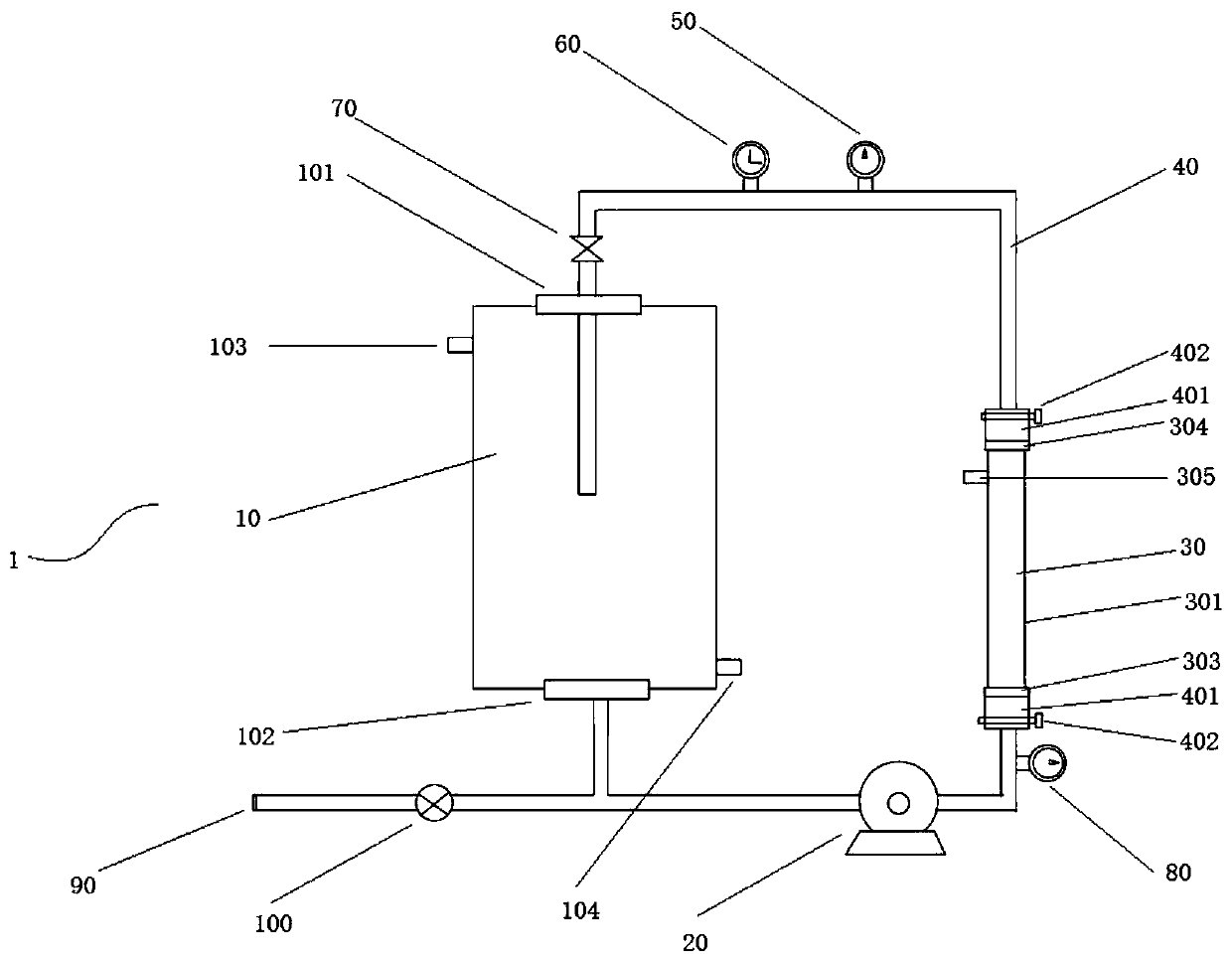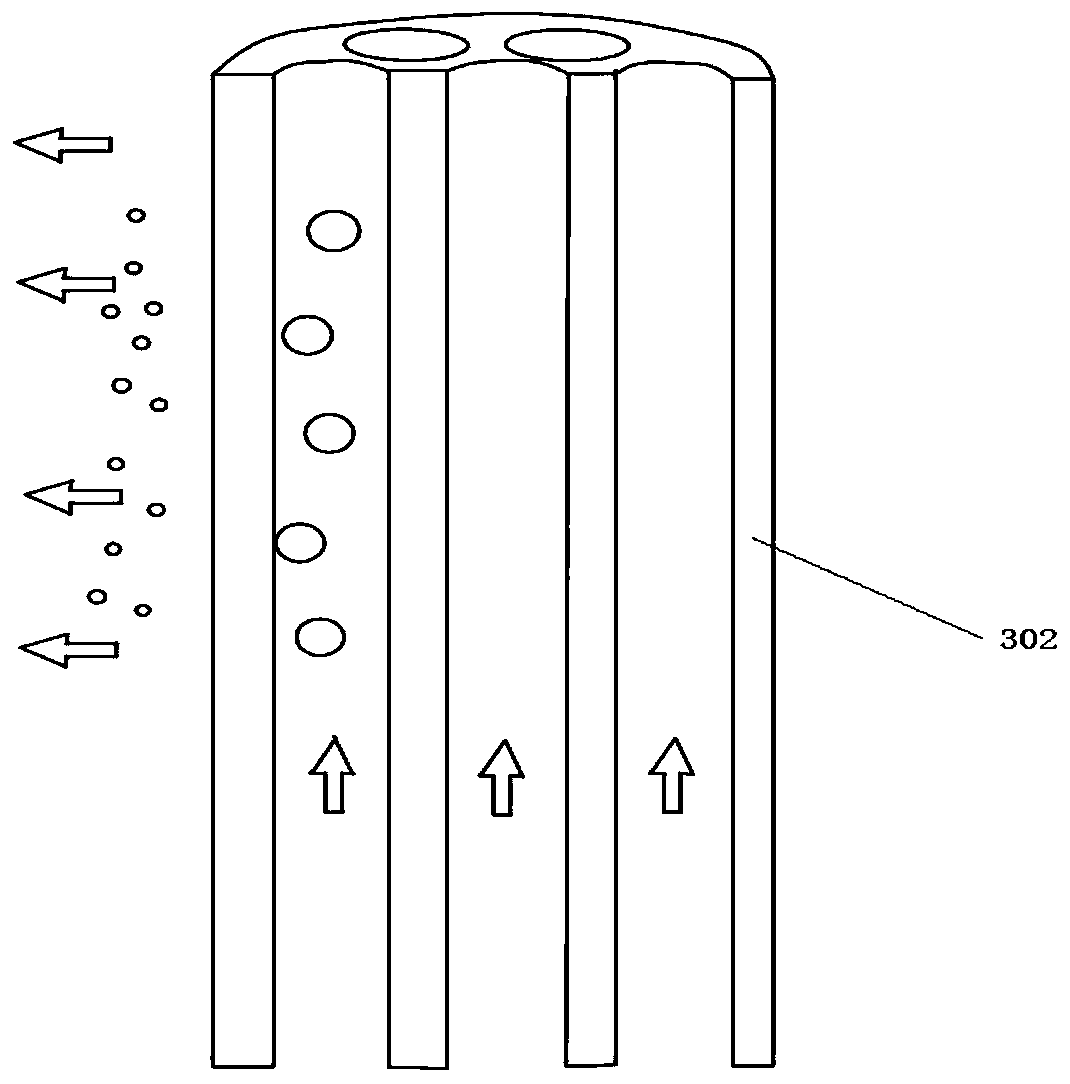Waterbody pathogen concentration apparatus and concentration method
A technology for concentrating devices and pathogens, applied in the field of microbial detection, can solve the problems of effective application range, large volume, difficult detection, etc., and achieves the effects of not affecting the complete collection of pathogens, simple device structure, and ensuring reliability.
- Summary
- Abstract
- Description
- Claims
- Application Information
AI Technical Summary
Problems solved by technology
Method used
Image
Examples
Embodiment 1
[0042] Example 1: A water body pathogen concentration device
[0043] refer to Figure 1-4, the present invention provides a water pathogen concentration device 1, said device 1 comprising: a water tank 10, a water pump 20, a pathogen concentrator 30 and a connecting pipe 40 for connecting the above components, wherein the outlet of the water tank The water port 102 is connected with the water inlet 303 of the pathogen concentrator, and the first water outlet 304 of the pathogen concentrator is connected with the water inlet 101 of the water tank, so the water pump 20 is located at the water outlet 102 of the water tank and between the pathogen concentrator. Between the water inlets 303. In this embodiment, the water body to be concentrated is injected into the water tank 10 through the water tank water inlet 101, and the water outlet 102 of the water tank is connected with the water pump 20, and the water pump 20 is used to pump the water in the water tank 10 into the path...
Embodiment 2
[0065] Embodiment 2: the concentrated detection of PMMoV plant virus in the water body
[0066] The concentration device is installed with a 500nm pore size inorganic ceramic ultrafiltration membrane. First, the water to be tested (50L raw water) is filtered through a 600-mesh stainless steel mesh to filter large particles such as duckweed and gravel, and the filtered water is slowly poured into the tank. First use the 500nm aperture inorganic ceramic ultrafiltration membrane (pressure 0.2MPa, temperature 10-40°C) to retain the filtrate (called 500nm filtrate). The 500nm filtrate was slowly injected into the tank again, and filtered with a 50nm pore size inorganic ceramic ultrafiltration membrane (pressure 0.2MPa, temperature 10-40°C). After the filtration is completed, take out the ultrafiltration membrane, and use a 50mL syringe to rinse with 20-50mL 1×PBS several times, and the final rinse solution is the concentrated solution. Draw 5 μL each of raw water, concentrated s...
Embodiment 3
[0067] Example 3: Bacterial Filtration
[0068] Install the concentration device with a 500nm pore size inorganic ceramic ultrafiltration membrane, first pass the water to be tested through a 600-mesh stainless steel mesh to filter large particles such as duckweed and gravel, and then slowly pour the filtered water into the tank. First use inorganic ceramic ultrafiltration membrane with a pore size of 500nm (pressure 0.2MPa, temperature 10-40°C) to retain the filtrate. Take 100 μL of raw water and 500nm filtrate and spread them on LB medium, and culture them at 28°C for 48 hours. The results show that the number of colonies in raw water is significantly higher than that in filtered water ( Figure 5 ), indicating that the device can retain most bacteria.
PUM
| Property | Measurement | Unit |
|---|---|---|
| pore size | aaaaa | aaaaa |
| diameter | aaaaa | aaaaa |
Abstract
Description
Claims
Application Information
 Login to View More
Login to View More - R&D
- Intellectual Property
- Life Sciences
- Materials
- Tech Scout
- Unparalleled Data Quality
- Higher Quality Content
- 60% Fewer Hallucinations
Browse by: Latest US Patents, China's latest patents, Technical Efficacy Thesaurus, Application Domain, Technology Topic, Popular Technical Reports.
© 2025 PatSnap. All rights reserved.Legal|Privacy policy|Modern Slavery Act Transparency Statement|Sitemap|About US| Contact US: help@patsnap.com



